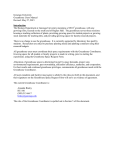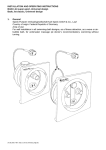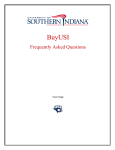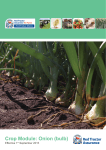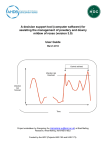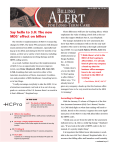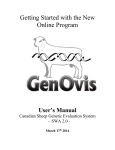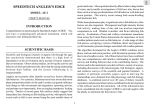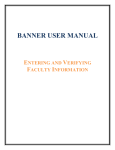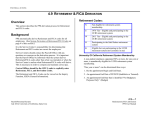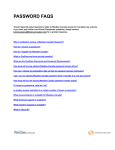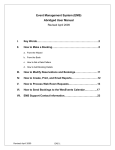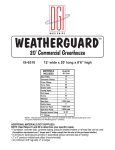Download Greenhouse User Manual - Rose
Transcript
William A. Cook Laboratory for Bioscience Research Rose- Hulman Institute of Technology User Manual Revised: July 11, 2014 Introduction The Biology and Biomedical Engineering Department at Rose-Hulman Institute of Technology University maintains a 1300 ft2 greenhouse, with one growing room, located on the south wall of Crapo Hall. The greenhouse serves three missions: housing a teaching collection of plants, providing growing space for student projects or growing stock materials for teaching labs, and providing growing space for faculty research projects. There is no charge to use the greenhouse. It is currently supported by laboratory fees paid by students. Researchers are asked to purchase planting media and planting containers using their research budgets. All greenhouse users must coordinate their space requirements with the Greenhouse Coordinator. Growing space for all student or faculty projects is made in writing, prior to starting the experiment, using the Greenhouse Space Request Form. Allocation of greenhouse space is determined in part by space demands, project size, environmental requirements, past performance, utilization efficiency, sanitation, and cooperation. For best results and continued greenhouse privileges, communicate all greenhouse needs with the Greenhouse Coordinator. All users (students and faculty) must agree to abide by the rules put forth in this document, and their signatures on the Greenhouse Space Request Form will serve as evidence of agreement. The current Greenhouse Coordinator is: Shannon Tieken CM 4028 (812) 877-8997 [email protected] The role of the Greenhouse Coordinator is spelled out in Section 5 of this document. Section 1: Rules 1. Consult the Greenhouse Coordinator before starting a new project. 2. All automated systems are set by the Greenhouse Coordinator. Do NOT attempt to reprogram any controller. Please request changes from the Greenhouse Coordinator. 3. Please DO NOT move any plants (even your own) without consulting the Greenhouse Coordinator. 4. The Greenhouse and the Greenhouse Support Area should be kept free of contaminants (biological or chemical). 4.1. There is NO SMOKING in either area. 4.2. No field samples or equipment should be stored or processed in either area without prior approval from the Greenhouse Coordinator. 5. Use only fresh planting media. No “re-used” soil or homemade compost should be used in the greenhouse. 6. Use only new or cleaned, chemically sterilized pots or containers. Pots and flats may be sterilized with a 10% bleach solution. 7. Use clean tools. Tools may be wiped with rubbing alcohol before and after use. 8. Clean up after yourself. 8.1. Remove soil and litter from your work area and spray the counter with a 10% bleach solution when you are done working 8.2. Keep your growing area free from soil and leaf litter 8.3. Dispose of dead, diseased, or contaminated plants immediately 8.4. Remove all materials at the end of your experiment 8.5. Wash all containers with soapy water at the end of your experiment 9. Do NOT rinse, sweep, or dispose of soil into the floor drains. 10. Turn off the hose when you are finished with it. 11. Close all cabinet and room doors when you are done for the day. 12. The greenhouse is a Integrated Pest Management (IPM) facility which means not all insects are unfavorable. Do not spray or kill anything. Pest control is coordinated by the Greenhouse Coordinator. Report any pest issues to the Greenhouse Coordinator immediately. 13. The greenhouse is for growing plants, NOT for storing supplies. No storage is allowed on the work surfaces. 14. Do not bring personal plants from home or outside the greenhouse into the lab for storage or rehabilitation. Pests and/or diseases may compromise the research being conducted elsewhere in the facility. 15. Initial rule violations will be discussed between the Greenhouse Coordinator, the user, and the user’s supervisor (faculty mentor). Continued rule violations will be documented in writing (or by email) by the Greenhouse Coordinator and sent to the user (or the user’s supervisor) and to the Department Chairperson. Continued violations of greenhouse rules will result in forfeiture of greenhouse privileges. Section 2: Procedures for Requesting Space All requests for greenhouse space must be made in writing to the Greenhouse Coordinator, preferably at least 1 month prior to planting. Please use the following protocol: 1. Initiate your request via email to the Greenhouse Coordinator. 2. You will be asked to fill out the Greenhouse Space Request Form. 3. Formal discussion will occur between the user (user’s supervisor) and the Greenhouse Coordinator. 4. Space allocation will be based on Section 3: Space Allocation Limitations of this document. 5. Space allocation will be granted or denied in writing or email. 6. Any space allocation grievances should follow the protocol specified under Section 4: Space Allocation Grievances. 7. Greenhouse use may begin after receipt of written permission AND after all users and workers have had an orientation training session in the greenhouse with the Greenhouse Coordinator. 8. Greenhouse space is not granted indefinitely. You must list an end date. All allocations will be reviewed annually, approximately on the anniversary date of the approved allocation. Section 3: Space Allocation Limitations 1. The Teaching Collection cannot be regularly discarded and replaced. One watering station will be allocated for the Teaching Collection year-round. 2. Classroom (curricular) uses have priority for space during the academic year. This is for student research projects or growing stock plant materials such as peas for laboratory exercises. Other users may request unused space from the Greenhouse Coordinator. 3. A minimum of 2 watering stations will be available for faculty research year-round. Other users may request short-term use of any unused space from the Greenhouse Coordinator. 4. Other members of the RHIT community may request space from the Greenhouse Coordinator. Space will be given as it is available on a first come, first served basis after all teaching, coursework, and research needs have been met. 5. Space will NOT be granted to individuals seeking to overwinter or rehabilitate personal plants. Section 4: Space Allocation Grievances 1. Every effort will be made to accommodate all users. 2. In general, space will be allocated based on the priorities established here (Section 4 of Rose-Hulman’s Greenhouse User’s Manual) in parts 3 through 7. Other considerations include past cooperation and adherence to the rules spelled out in this document. Space allocation limitations are spelled out in Section 3 (above). 3. When space for coursework becomes limited, priority will be given to the classes with the largest demand for space (typically the largest enrollment courses). 4. Classes for Biology Majors will be given priority over non-majors courses. 5. Research priority will be given to the most junior, non-tenured faculty mentor in an effort to foster professional development. 6. A funded project receives priority over non-funded projects. A project specifically designed to generate preliminary data for a grant application (but not yet funded) will be given special consideration on a case-by-case basis, but should generally receive a higher priority than a project with a more flexible time-line. 7. Faculty mentors working with students receive priority over faculty working independently. 8. In the event that space conflicts cannot be resolved between the interested parties and the Greenhouse Coordinator, the Greenhouse Users Group will consider the options and propose a solution. 9. If the situation is still unresolved, the Department Chairperson will mediate the conflict OR declare a solution, at his or her discretion. If the Department Chairperson is one of the interested parties or is related to one of the interested parties, then the most senior, independent, Biology Department faculty member will mediate OR declare a solution, at his or her discretion. Section 5: The Greenhouse Coordinator The job of the greenhouse coordinator includes: 1. Working with multiple Department users to assign space in the growing area. 2. Determining, maintaining, and monitoring appropriate environmental settings and watering regimes throughout the greenhouse based on user requests. 3. Attending to greenhouse maintenance and pest control (working with Facilities and outside vendors as needed). 4. Monitoring plant care for the teaching collection and classroom stock materials. 5. The Greenhouse Coordinator will only care for research projects when such care has been specifically requested by the researcher (student, staff, or faculty). Researchers requesting plant care should provide a written protocol for care (watering, fertilizing, etc.) to the Greenhouse Coordinator. 6. Maintaining and developing the teaching collection to provide materials requested by the Department faculty and staff to supplement curriculum. 7. Stocking greenhouse supplies for the teaching collection and course materials. Stocking supplies for faculty research projects will be done only when requested and should be paid for by the faculty mentor. 8. Assisting with other duties such as designing, planting, and monitoring research projects when specifically requested. Section 6: Conditions and Definitions Automated Systems: Irrigation, light, heating, and cooling are separately computer controlled. Classroom projects/materials: Rose-Hulman’s teaching mission dictates that space be available for growing classroom materials (stock materials such as peas) or class research projects. This use is anticipated to be larger during the academic year and much smaller for summer courses. Environmental settings: Irrigation, light, heating, and cooling. Faculty research: Faculty research projects include those specifically designed to test hypotheses developed by Department faculty or staff. These projects may be part of a funded grant or aimed at generating data to support a grant application. More research space can be made available as class demands diminish over the summer. Greenhouse Coordinator: A staff member of the Biology and Biomedical Engineering Department with advanced training in Botany, Agriculture, Horticulture, or similar Biological field whose task is to maintain a functional research and teaching greenhouse as specified above in Section 5. Growing Space: Growing space in the greenhouse consists of 30 3 ft. x 5 ft. benches arranged in pairs. Floor space in the greenhouse measures 20 ft. x 46 ft, or approximately 920 square feet. Heating and Cooling: Heating and cooling settings are applied to the entire growing area. The Greenhouse Coordinator will determine, set, and maintain seasonally appropriate temperatures that accommodate the greatest diversity of plants in the growing space. Independent faculty member: A member of the Rose-Hulman Institute of Technology faculty not directly involved in or related to someone involved in any greenhouse use issue. Lighting: Lighting conditions must be applied to the entire growing area. A shade curtain can filter ambient sunlight and metal-halide lamps can extend the photoperiod. While the filter or lamps are applied over the entire growing area, light availability varies throughout the greenhouse and varies throughout the year. Nutrients: Fertilization is manual, using either tap water or de-ionized water in a watering can. A semi-automated system is available for fertilizing using tap water. Teaching Collection: Due to the varied light and water requirements of plants kept in the teaching collection, they will occupy a variety of benches throughout the greenhouse. It may be difficult to condense these plants as space demands increase. Watering: Each bench pair (4 ft. x 12 ft.) can be watered automatically by one of 4 water control stations. Each water control station can drip irrigate approximately 60 pots per bench pair. Tap water is available for manual watering. Figure 1: A flow diagram showing the allocation protocol for growing space in the Biology Department’s greenhouse. Arrows represent the priorities for assigning the remaining space available for each use category. Teaching Collection Coursework Research 1 watering station 2 watering stations. Courses for Biology Majors Most Junior and/or non-tenured tenure track faculty mentor 1 watering station Largest Enrollment Other Faculty Mentors Upper Division Non-Majors Discretion of Department Chairperson OR most senior independent faculty member of the department Other RoseHulman Institute of Technology Community Uses Currently Funded Projects






